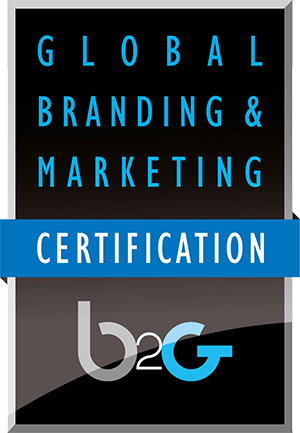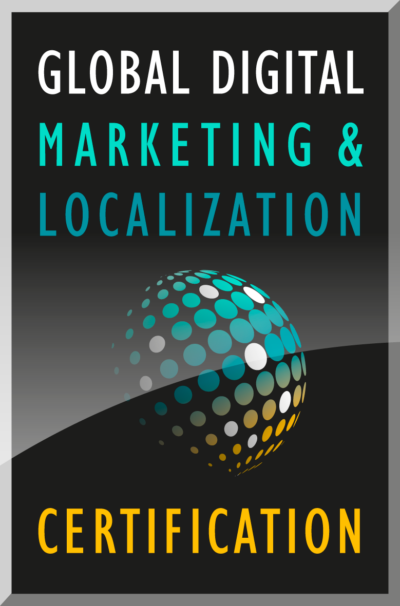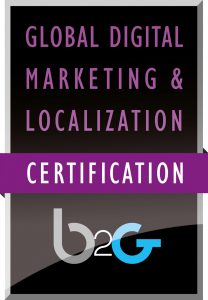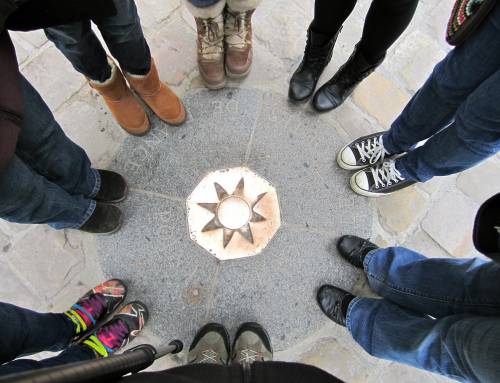This is a paper presented by Nickson Cheng, a recent graduate of both the Global Digital Marketing and Localization Certification (GDMLC) program. This paper presents the work being produced by students of The Localization Institute’s Global Digital Marketing and Localization program. The contents of this Paper are presented to create discussion in the global marketing industry on this topic; the contents of this paper are not to be considered an adopted standard of any kind. This does not represent the official position of Brand2Global Conference, The Localization Institute, or the author’s organization.
What comes to your mind when you hear Machine Translation (MT)? Do you think of Google Translate? Inaccurate translation? Fast translation? AI taking over yet another job? Does it conjure bleak images that extend to paranoia of Artificial Intelligence (AI) taking over almost every façade that makes us human and ultimately conquering and taking over the world in future and making all of us redundant?
Maybe not. Not yet, at least.
Machine translation has been around for a very long time. In almost every international localization and translation conferences dating as far back as the 1990s and that’s more than 20 years ago, there has been technologist touting the demise of human translators. Yet, after years of advocating this “take-over”, human translators remain the staple in most multilingual communication requirements globally.
The new normal these days, is that advances in technology has made many jobs obsolete.
Here, we will not be dwelling much on what constitute MT and its development over the years here. What we will be discussing is the impact of the development of MT on translators and the language industry and we will also be sharing our observation on how we can, in the face of these fierce technological advances, adapt and adopt to ensure we, as human, still have an important role to play in the future of translation.
Over the years, technological advances in Artificial Intelligence have hastened the pace of evolution of Machine Translation so much so that it has been touted as the replacement for human translators. Many in the IT world have warned of the pending “demise” of human translators, suggesting that human translators might no longer be relevant in the future.
There are evidence and signs that this possible replacement of human translators may be more worrying and closer than we think. These recent successes in the development of machine translation has been seen by many outside the translation industry as a huge advancement and that human translators and thus the language industry will be “annihilated”.
While we cannot deny that AI has consistently been replacing human in many areas, but when it comes to translation, the human brain is by far the best technology that is available. While we are of the opinion that machine translation will not replace human translation in the near future, we cannot be blind to the fact that rapid machine translation improvement with major global players investing heap-loads of money in it, will get better. Much better. It could even reach a point where it will become “good enough” for most people.
Instead of going against the flow and making the future transition a tough one, a collaborative stance should be taken, not as a surrender to technology but more of an effort to improve and increase the effectiveness and productivity of translation to facilitate multilingual communication for the future.
There is a common Chinese saying: 知己知彼 百戰百勝. Roughly translated it means “To know your own weaknesses and strengths and that of your enemies’, guarantees a hundred victories in a hundred battles”. The key principle at work here is “WITH” not “AGAINST” technology.
Translators have been working with technology by incorporating the use of Computer-Assisted Translation (CAT) tools with human translation effort for quite some time already. What was seen initially as a threat soon turned into acceptance when it was clear to many that CAT tools can increase translators’ productivity rather than replace them. Perhaps, if MT is seen in the same light, human translators will learn to work with it rather than reject it.
There are several ways to go about working “WITH” technology. In general, what we want to do here, whether as independent translators or as translation companies, is to have control over the processes. Below are some ways (non-exhaustive of course) that human translators and language service providers can work “with” technology and while doing so, lay good foundation for our very existence for the future of translation.
Be a Professional Translator and more
Be a professional translator. Get a professional translation qualification and get certified. Hone your skills. Embrace specialisation by being an expert in a certain language pair, subject matter, market, field and industry. Don’t limit yourself to just being a translator. Be a linguistic advisor. Be ready to collaborate with other professional translators. Be business savvy. Market yourself like a business with best practices to set yourself apart from the lot. Be an expert in the use of CAT tools and MT software. Do not have this mindset that you are losing jobs to AI with their MTs but instead, think of the deficiencies of MTs and how you, as a human translator, can fill those crucial gaps. Leave the translation of simple and repetitive materials to AI. You should tap on your strength as professional linguists to do what MT cannot do.
In fact, the downsides of MT are the exact reasons why human translators will still be the default option. With MT taking over the bulk of the repetitive translation work, human translators will be left with translation work requiring more accuracy and creativity. We can offer Transcreation which requires more creativity and cultural fluency. With more care and expertise to produce higher quality translation of higher priority content, there is even a possibility of human translators being paid more for these jobs.
Be an Editor and a Reviser
Don’t be a stick in the mud and reject jobs that are not considered translation. Expand your repertoire by offering editing and preparing source text for translation. This is usually a process that is largely ignored by many, leading to very flawed translation output.
Be a reviser for target text. This should not be confused with revising target text against source text. The problem with translation produced by MT is that the sentences can be rather awkward as MT does not possess the ability to investigate, verify and dig deep to understand the true meaning of the content.
As a reviser for the target text, you can provide “tidying up” service for the MT translation. As a value-added service, you can also point out discrepancies and illogical flow of content and information for the originator to investigate it further. Now, machines can’t do that, can they?
Get involved
It is inevitable that MT is here to stay. It will become a staple in many translation projects and its importance in the translation process will likely increase with time. In order for the output of any MT to be good enough, its input must be of a good quality. High quality training data must be created and prepared. For now, this part of the job is very much reliant on professional linguists who can discern between high quality input and rubbish ones.
Given the amount of training data required, the demand for professional linguists to curate, sort and prepare meaningful information will be high. Translators can play an important role in the preparation of these high-quality training data.
BYOMT – Build your own MT
One of the best ways of dealing with change is to embrace it. There various solutions, both open-source and closed-source, available to build your own MT. However, this is an undertaking usually not considered as an option for independent translators as the amount of time, expertise and cost involved can be quite huge.
Language Service Providers (LSP) and specialised localisation departments are likely adopters of this possible solution as they have the resources to adopt a baseline MT software and train the MT by loading huge amount of parallel texts, terminologies, abbreviations etc in two languages most likely in a specialised domain such as medical. It is an ongoing process and the MT quality is tested and refined with input of more translated data. Once credible translation can be produced by the MT, it can increase the competitiveness of the LSP by reducing its overall translation cost and shortening the delivery timeline for the languages involved. The translation, done by a purposefully built MT and edited by human, can be used to target very specialised clients.
LSP can offer this standalone standard MT service without human review as a cheaper option to their clients. As a way to increase profit margin and reducing translation costs, LSP can also use these specialised MT along with the deployment of editors, rather than translators, without disclosing it to their clients. Whether this is ethical or not is a topic that has to be discussed in more details and at another time.
MTPE – Machine Translation Post-Editing
Machine Translation Post-Editing (MTPE) is a process of passing the source text through an MT before having the translated text edited by an editor. This method admits to the flaws of MT and it requires human intervention to achieve final translation output that is acceptable. Post-translation editing is not new. It is common for translators to proofread or post-edit their own translation as part of a QA process. However, in order for MTPE to reap any benefits, apart from building and utilising a credible MT, it should include and allow for the following process:
- Post-Editing training for appointed linguists
- Efficient and specific linguistic feedback
- Efficient Post-Editing process
MTPE is an extension of BYOMT. While BYOMT is sometimes done without the knowledge of the client, MTPE is openly offered to the client as part of a suite of services. Unfortunately, although we have seen more LSPs providing MTPE as a service, there are still many independent translators resisting or even openly challenging and rejecting MTPE.
There are other permutations of the above-mentioned methods of working with technology. Most human translators would still favour working with CAT tools rather than MT. With AI evolving so fast, it is a matter of time, before we will see a total assimilation of the CAT tools into the MT process.
Translation service has always been customer focused in that the translation output has to facilitate multilingual communication and to be fit for its purpose. With a variety of the permutations of translation services offered, customers will choose one that fit their agenda and budget.
If human translators and LSPs alike can leverage technology and be a part of the future translation processes rather than rejecting it totally, we will stand to gain and be in control. This is opposed to ignoring the reality and insisting that human translators will never be replaced. A sure way to be replaced.
While language is subjective and thus translation, as human translators, we must be aware of the development of MT and how we must harness the power of technology to help us stay relevant. There is little doubt that AI can ultimately develop linguistic capabilities for our natural languages and because of that, all jobs in the language industry would be in danger of being made obsolete.
However, instead of worrying about this happening or living in denial, we should be taking the cue from many other industries that has thrived with technology. Yes. For now, language professionals should focus on how we can use technology to be more competitive, more efficient and more effective.
Author Bio:

Nickson Cheng has a decorated history of working in the translation and localization industry since 1995. Nickson is the Managing Director of Lingua Technologies International, a Singapore-based LSP. He is also the chairman of GCBG, an exclusive global alliance of leading LSPs from different continents. Strong entrepreneurship professional skilled in Multilingual, Negotiation, Linguistics, Translation, and Foreign Languages. An expert in spearheading businesses and establishments in new territories.
Connect with Nickson:
Connect with Nickson on LinkedIn
Email: nicksoncheng[at]translationsingapore.com.sg
Website: https://www.translationsingapore.com and https://www.gcb-group.com
Having been in the industry since 1995, I badly needed an update or a refresher on the Localisation and Translation Industry. A new perspective, perhaps. I was not looking to affirm what I already know. I want to know what’s new and a little more. The Global Digital Marketing and Localization Certification program happened to be the one I was looking for. The online program allows busy working adults to learn at their own pace. With practical examples and interviews with industry experts, Dr. Singh, leads learners to explore new ideas and ways that can be adapted and applied in different scenarios. The administrative support rendered by Brendan Keating is also quick, sincere and flawless. I would totally recommend this course to anyone, rookies and the experienced alike.
References:
- https://www.gala-global.org/what-machine-translation – Language Technology – Machine Translation
- https://www.hedden.org/intro_mt.html#:~:text=Definitions,file%20in%20another%20computer%20language. – Machine Translation: A brief introduction
- https://www.at-it-translator.com/i-dont-offer-machine-translation-post-editing-here-is-why/ – I don’t offer machine translation post-editing service, here is why. By Anthony Teixeira
- https://translationsinlondon.com/what-is-mtpe/ – Machine Translation and MTPE
Disclaimer











